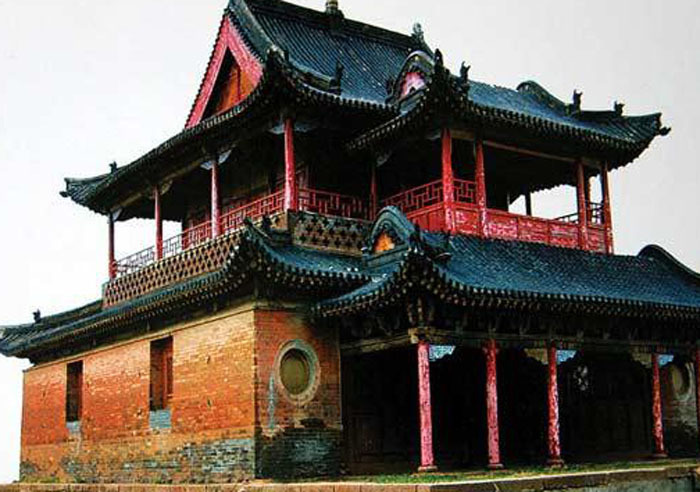
Lvya Temple in Mile City, Honghe
Overview
Lvya Temple (绿崖庙) is located in Midong Township, Mile City (弥勒市), Honghe Prefecture (红河哈尼族彝族自治州), Yunnan Province (云南省). It was established in the 32nd year of the Qianlong reign of the Qing Dynasty (清朝) in 1767 and has undergone several renovations since.
- Area: 1,084 m²
- Established: 1767
Architectural Features
Lvya Temple faces southeast and covers an area of 1,084 square meters. The layout includes a main hall, side halls, and two ear halls, with the two ear halls featuring a double-eaved hip roof, while the others have a single-eaved structure. A prominent hexagonal pavilion with a double-eaved spire is built on a giant stone peak behind the main hall, accessible via a path of 23 steps.
The temple is surrounded by ancient cypress trees and golden bamboo groves, next to the Dianxi River (甸溪河), with small streams flowing around it. The streams enter a crescent pond near the pavilion, where a stone dragon head sculpture directs the water. In 1981, Lvya Temple was designated as a protected cultural site in Mile County.
Natural Environment
Honghe Prefecture is located in the southern Yunnan-Guizhou Plateau, characterized by a variety of landforms, including limestone mountains, plateaus, valleys, basins, and hills. The area experiences significant elevation changes, with a complex topography, abundant rainfall, sufficient sunlight, and a mild temperature range. The climate is primarily subtropical highland monsoon.
Due to the Tropic of Cancer passing through the region, temperatures and humidity increase from north to south, exhibiting a humid and hot characteristic. The rainy season occurs from May to October, while frost is common from late November to February. Therefore, the best time to visit Honghe is during the mild and less rainy months of March to April and September to November.
Temple Layout and Historical Significance
Lvya Temple is positioned next to the Dianxi River, with the existing structures dating back to the Guangxu period (光绪) of the Qing Dynasty, aside from the demolished front hall. The temple features a unique architectural design, with a two-story main hall having a single-eaved hard mountain roof. Side rooms also share this architectural style, with Western-style door openings popular during the Republic of China period connecting to the back rooms.
Behind the front hall lies a honeycomb-shaped rock surrounded by water flowing into a crescent pond. Above this, a hexagonal pavilion is built, with plaques hanging that read “Bamboo Green” (竹翠) and “Lotus Fragrance” (莲香), dedicated to the deity Kuixing (魁星). The temple’s tranquil environment is enriched by ancient trees and banana plants, creating a serene atmosphere.
Visitors can ascend from the second floor of the main hall via stairs to overlook the lush landscape along the Dianxi River, where fields stretch for miles and mountains loom in the distance. This temple is one of the few remaining ancient religious structures in Yunnan that perfectly blends temple architecture with garden design.
The current structure reflects the renovation in the 24th year of the Daoguang period (道光) and contains inscriptions that are vital for studying the history of Lvya Temple.
How to Get There
Lvya Temple is approximately 5 kilometers from Mile City. You can take a local bus or hire a taxi to reach the temple area. Look for signs directing you to Shiyanjiao Village (弥寺哨村) near the Dianxi River.
Travel Tips
- Best Time to Visit: March to April and September to November for pleasant weather and fewer rains.
- What to Bring: Comfortable walking shoes, a camera, and some snacks or drinks for the trip.
- Cultural Respect: Be mindful of local customs, especially when visiting the temple, as it holds significant cultural and historical value.
- Photography: Capture the stunning architecture and natural surroundings, but be respectful of sacred areas.


 7 Days GolfingTour
7 Days GolfingTour
 8 Days Group Tour
8 Days Group Tour
 8 Days Yunnan Tour
8 Days Yunnan Tour
 7 Days Shangri La Hiking
7 Days Shangri La Hiking
 11 Days Yunnan Tour
11 Days Yunnan Tour
 6 Days Yuanyang Terraces
6 Days Yuanyang Terraces
 11 Days Yunnan Tour
11 Days Yunnan Tour
 8 Days South Yunnan
8 Days South Yunnan
 7 Days Tea Tour
7 Days Tea Tour
 8 Days Muslim Tour
8 Days Muslim Tour
 12 Days Self-Driving
12 Days Self-Driving
 4 Days Haba Climbing
4 Days Haba Climbing
 Tiger Leaping Gorge
Tiger Leaping Gorge
 Stone Forest
Stone Forest
 Yunnan-Tibet
Yunnan-Tibet
 Hani Rice Terraces
Hani Rice Terraces
 Kunming
Kunming
 Lijiang
Lijiang
 Shangri-la
Shangri-la
 Dali
Dali
 XishuangBanna
XishuangBanna
 Honghe
Honghe
 Kunming
Kunming
 Lijiang
Lijiang
 Shangri-la
Shangri-la
 Yuanyang Rice Terraces
Yuanyang Rice Terraces
 Nujiang
Nujiang
 XishuangBanna
XishuangBanna
 Spring City Golf
Spring City Golf
 Snow Mountain Golf
Snow Mountain Golf
 Stone Mountain Golf
Stone Mountain Golf



















